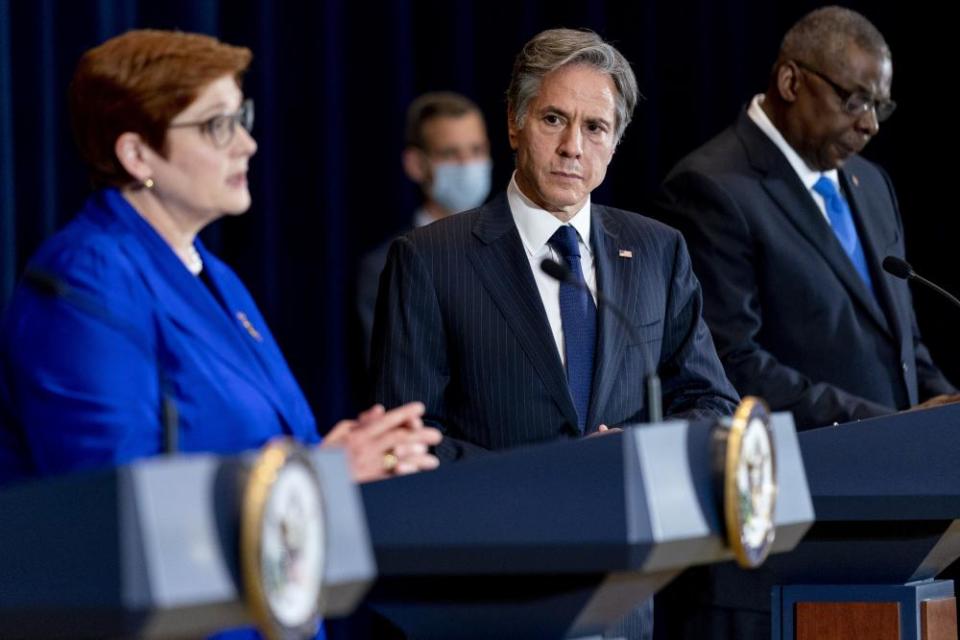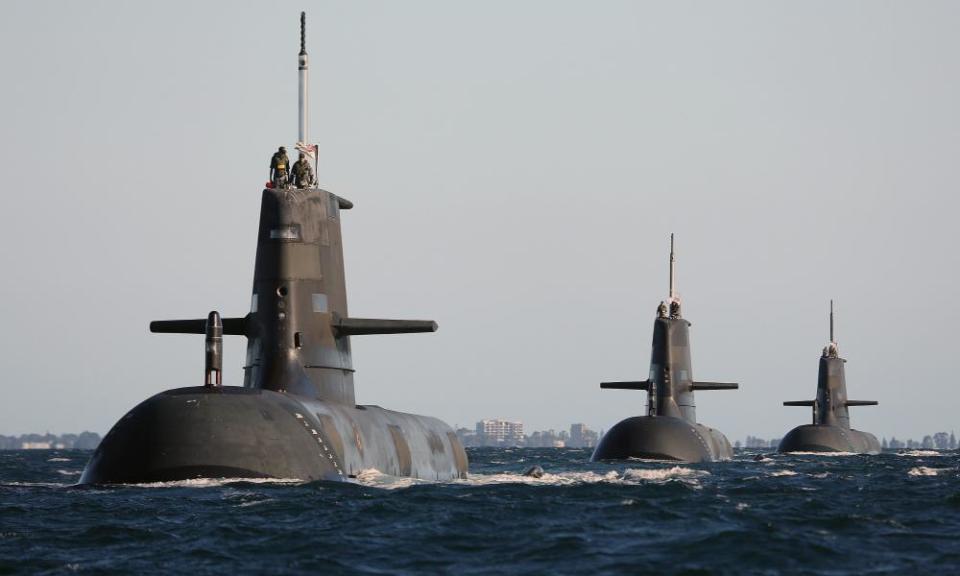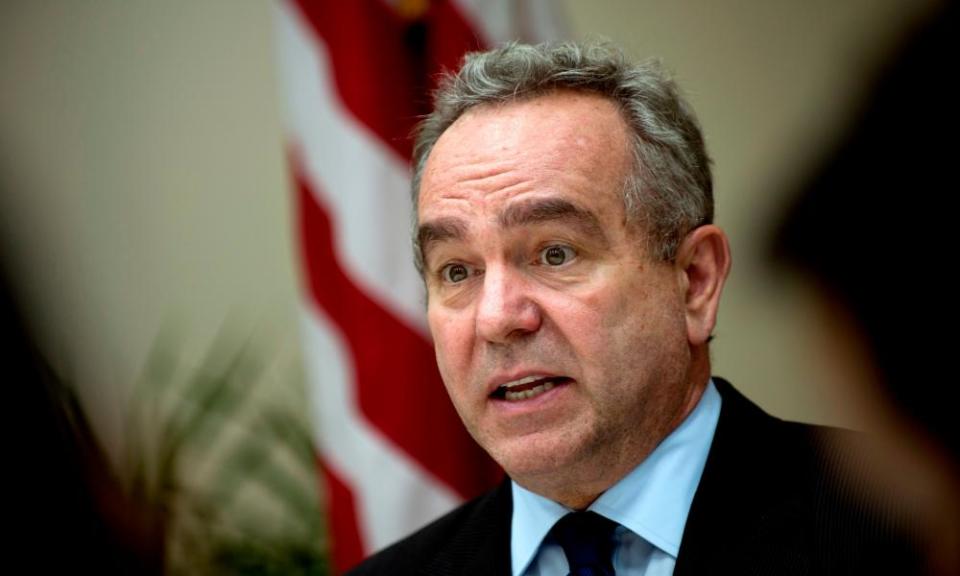Under the radar: the Australian intelligence chief in the shadows of the Aukus deal
It was late April when one of Australia’s top intelligence chiefs arrived in Washington for important talks with key officials in the relatively new Biden administration.
Andrew Shearer, a longtime foreign policy hawk and one of Scott Morrison’s most influential advisers on how Australia should position itself at a time of rising tensions with China, met with Joe Biden’s top Indo-Pacific adviser, Kurt Campbell, in the building next to the White House on 30 April.
The head of Australia’s Office of National Intelligence was joined by the Australian ambassador to the US, Arthur Sinodinos, for the discussion, held in room 386 of the Eisenhower Executive Office Building – a 19th-century government premises described as “one of America’s best examples of the French Second Empire style of architecture”.
They would have had plenty to talk about. Campbell – the architect of Barack Obama’s “tilt” to Asia that, among other things, began the rotation of US Marines through Darwin – had already pledged publicly that the US would not “leave Australia alone on the field” in the face of “economic coercion” from Beijing.
Related: The nuclear option: why has Australia ditched the French submarine plan for the Aukus pact?
But it just so happens April was an important month for what would later become the Aukus security deal with the US and the UK, triggering a rift with France. April is when it became clear to the Australian government that the idea of getting help to acquire nuclear-powered submarines could advance into the American political system.
So, was the well-connected Shearer’s previously unreported trip to the US a key plank in Australia’s efforts to advance the Aukus plans?
Neither side will say, such is the sensitivity about the negotiations. The events have become highly controversial, amid accusations by France that it was “stabbed in the back” and deliberately kept in the dark by its friends, prompting Paris to recall two ambassadors.
ONI, the prime minister’s office and the Biden administration all declined to comment on the purpose of Shearer’s late-April trip and whether the plan to share sensitive submarine technology was discussed.
“Dr Campbell meets with Australian officials frequently to discuss the full range of issues in the US-Australia relationship,” a senior Biden administration official said.
The ‘betrayal’

Sinodinos was back at the Eisenhower Executive Office Building to see Campbell just two weeks later. This time the ambassador – a former Coalition cabinet minister – was joined by the Australian foreign affairs minister, Marise Payne.
Payne also met with the US secretary of state, Antony Blinken, and with Biden’s national security adviser, Jake Sullivan, during her stop in Washington. There was gathering momentum for closer security cooperation. “We have each other’s backs,” Blinken said, “so we can face threats and challenges from a position of collective strength.”
Just a month later, Scott Morrison met with Biden and the UK prime minister Boris Johnson in a trilateral meeting on the sidelines of the G7 in Cornwall. At the June meeting, the trio are understood to have made progress on the broad outlines of what would later become Aukus.
Morrison told reporters at the time he and Biden and Johnson had discussed “the Indo-Pacific situation” – code for China – and argued it “only reinforces the need for us to have deeper cooperation”.
But the “forever” partnership wasn’t finalised and announced until mid-September. Indeed, Morrison stopped into Paris after the G7 for talks with the French president, Emmanuel Macron, apparently leaving the impression that they were making progress on hurdles with the $90bn deal for French-designed conventional submarines.
Angered by what it called a “betrayal”, the French government has not yet accepted Morrison’s request for a phone call with Macron. The White House has acknowledged there should have been better communication with France. Malaysia and Indonesia last week renewed their concerns that Australia’s plan to acquire at least eight nuclear-powered submarines could add to a regional arms race, while China’s foreign ministry said Aukus “may even lead to the collapse of the international nuclear non-proliferation regime”.
A ‘missed’ chance
Shearer, a longtime government official who once worked at the Australian embassy in Washington, had never been particularly keen on the French option to replace the six ageing Collins class submarines.
Shearer’s career history includes serving as a national security adviser to prime ministers John Howard and Tony Abbott.
Shearer was in Abbott’s office when the then prime minister was weighing up the submarine project. Abbott and Shearer are known to have been keen on acquiring submarines from Japan, whose government had come to believe it was the leading contender.
Under political pressure from South Australian Liberals, however, Abbott announced in 2015 a competitive process that would require a focus on maximising domestic shipbuilding jobs. That led Abbott’s successor, Malcolm Turnbull, to reveal the following year that Australia was partnering with France over Japan and Germany.
In April 2016, Shearer described the decision as a “historic missed opportunity”. Shearer saw it as “setback” in the push for closer defence ties with Japan amid China’s “increasing assertiveness in the South China Sea and East China Sea”.
In 2018, as director of the Alliances and American Leadership Project at the Washington-based Center for Strategic and International Studies, Shearer warned that China was consolidating its military forces and investing more in nuclear-powered attack submarines.

He argued Australia should respond by allowing “a rotational presence of US surface combatant vessels at HMAS Stirling in Western Australia (and consider the possibility of investing in the nuclear support infrastructure necessary for basing of attack submarines as well)”.
Shearer returned to government under Morrison’s prime ministership, first in a deputy position at ONI. In 2019 Shearer was appointed as cabinet secretary, a role that saw him part of deliberations on Australia’s toughening position towards China. Under Turnbull, Australia had already introduced foreign interference laws and banned Chinese telco Huawei from the 5G network.
But in 2020, the relationship between Australia and its top trading partner took a turn for the worse, with Beijing objecting to the Australian government’s early public calls for an independent international inquiry into the origins and early handling of the coronavirus outbreak. With Canberra also expressing concern about rights in Xinjiang and Hong Kong, Beijing froze talks with Australian ministers and rolled out a series of trade actions against export sectors including barley, wine, coal and seafood.
An influential voice
Shearer is seen as extremely influential in any policy debates related to the sharpening strategic competition between China and the US.
Shearer was a big supporter of elevating the Quad grouping among Australia, the US, Japan and India, arguing previously that “China’s authoritarian leaders have no respect for weakness” – language that has some resonance in Morrison’s pronouncements that the world is at risk of “a great polarisation” between autocracies and democracies.
Related: US urges UK to rebuild relations with Paris after submarine contract row
In a sign of the trust Morrison places in Shearer, the prime minister named him as the head of ONI last October, praising his “long and distinguished” career. The move triggered pushback from Labor, which argued a “partisan operative” should not be appointed to such a pivotal intelligence position.
While individual agencies like Asio and the Australian Signals Directorate produce reports to government, it is ONI’s role to compile “all-source intelligence assessments”.
In late September, following the Aukus unveiling, Nine reported Shearer was back in Washington with other Australian intelligence agency bosses to help institutionalise the new security partnership.

In Shearer’s earlier travels, in addition to the 30 April meeting with Campbell, White House visitor logs show the ONI director general met on 23 April with Biden’s deputy national security advisor for cyber and emerging technology, Anne Neuberger.
Australia later joined the US, the UK and other countries in publicly attributing malicious cyber activity to China.
Related: Timeline: how Australia’s submarines have evolved from world war one to Aukus
The Aukus partnership goes beyond submarines: cyber is one of the other areas in which Australia, the US and the UK have promised to deepen their cooperation.
About two months after the Shearer meeting, Campbell spoke at an Asia Society event and observed that China appeared to be trying to “cut Australia out of the herd”.
Campbell argued Beijing’s actions were backfiring: driving Canberra and Washington to “deepen” and “intensify” their relationship. Despite being of different political persuasions, Campbell added on 6 July, the Biden administration and the Morrison government shared “a tremendous sense of common purpose” on the challenges they were facing.
This Campbell webinar was pre-Aukus announcement, of course. He didn’t let slip anything about the nuclear submarine deal that Biden administration officials later described as Australia’s biggest strategic step in generations.

 Yahoo Finance
Yahoo Finance 